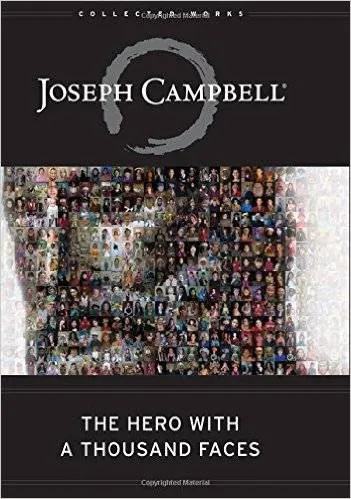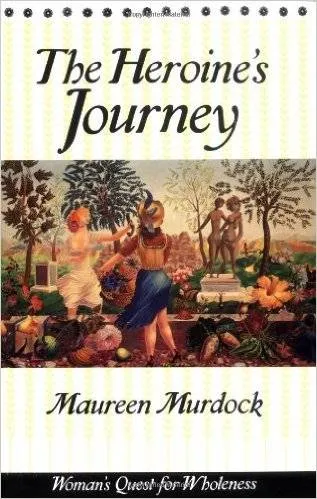
Anima House: How The Heroine’s Journey Made Me A Better Man
This content contains affiliate links. When you buy through these links, we may earn an affiliate commission.
Like lots of people, I rolled into ninth grade literature class a mishmash of pop culture role models, peer pressure, crippling insecurities and vaulting ambition. My internal compass was a reeling mess, and my vague idea of True North was, like, some amorphous notion that I should achieve greatness. Specific, right? When Mrs. Montgomery rolled out a lesson on Joseph Campbell’s model of the monomyth, The Hero’s Journey, I felt like I’d just been given the blueprints for life. For life! Plus, when I learned how closely my beloved Star Wars trilogy followed the journey, my little mind blew up like a thousand Death Stars and I knew at once my purpose. I wanted to be a hero. I felt the call—the first giant leap on this journey.
 In case you were sick that day in ninth grade, here is a one sentence recap of the stages of heroic development according to Campbell in his The Hero With A Thousand Faces : a young dude has to work hard against adversarial forces in order to acquire some external source of power so he can become a badass once and for all and return to his people with something remarkable to show for himself. Does he have to face some internal monsters as well as external ones? Sure, somewhat. But mostly the point is to achieve success as mastery, as dominance, as power, as greatness. And he does it all for a reward.
“Okay,” I said. “Cool. Let’s do this thing.” I was fourteen. Forgive me?
So I set out, keeping my eyes peeled for people from whom I could demand aid, for a weapon that would make me fearsome, for women looking to do me wrong, for a goddess to heal my wounds for me, and for an enemy to pin all my problems on.
It was miserable.
I made a bad hero, but I tried. For three decades I attempted to assert mastery over things, to force events to happen that I wanted to happen because they seemed to fit into my narrative, to sniff out monsters and sorceresses. And I told myself that if only I had that magic sword Campbell wrote about (lightsabers? Yes please!) life would be so easy and success would be inevitable. The magic elixir that Campbell wrote about was my birthright. Wasn’t it?
I got so busy trying to keep my eyes on the prize (money and fame, probably) (see also: gross) that I denied my inner life and so, to spare you a ton of details that might only bum us both out, I will leave it at this: my inner life suffered. Kind of a lot.
In suffering, in solitude, in stretches of time when life sucks so hard that we just want to slide down our bedroom door and have a long cry, we quiet down and we listen. In that stillness I heard a new call to a new adventure promising a new hope I did not find in Joseph Campbell or Star Wars or in so manny of our culture’s messages: the heroine’s journey.
In case you were sick that day in ninth grade, here is a one sentence recap of the stages of heroic development according to Campbell in his The Hero With A Thousand Faces : a young dude has to work hard against adversarial forces in order to acquire some external source of power so he can become a badass once and for all and return to his people with something remarkable to show for himself. Does he have to face some internal monsters as well as external ones? Sure, somewhat. But mostly the point is to achieve success as mastery, as dominance, as power, as greatness. And he does it all for a reward.
“Okay,” I said. “Cool. Let’s do this thing.” I was fourteen. Forgive me?
So I set out, keeping my eyes peeled for people from whom I could demand aid, for a weapon that would make me fearsome, for women looking to do me wrong, for a goddess to heal my wounds for me, and for an enemy to pin all my problems on.
It was miserable.
I made a bad hero, but I tried. For three decades I attempted to assert mastery over things, to force events to happen that I wanted to happen because they seemed to fit into my narrative, to sniff out monsters and sorceresses. And I told myself that if only I had that magic sword Campbell wrote about (lightsabers? Yes please!) life would be so easy and success would be inevitable. The magic elixir that Campbell wrote about was my birthright. Wasn’t it?
I got so busy trying to keep my eyes on the prize (money and fame, probably) (see also: gross) that I denied my inner life and so, to spare you a ton of details that might only bum us both out, I will leave it at this: my inner life suffered. Kind of a lot.
In suffering, in solitude, in stretches of time when life sucks so hard that we just want to slide down our bedroom door and have a long cry, we quiet down and we listen. In that stillness I heard a new call to a new adventure promising a new hope I did not find in Joseph Campbell or Star Wars or in so manny of our culture’s messages: the heroine’s journey.
 I understand I’m treading into sacred territory here, and the last thing I want is to barge in on a space dedicated for women and to colonize it. That’s not what I want at all. But, as Maureen Murdock explains in her pioneering book The Heroine’s Journey , we are all of us made up of the Jungian, archetypal masculine and feminine. These aren’t genders but rather forces within our character, aspects of ourselves called the animus and anima respectively. In the best possible circumstances they are parts working in tandem to make us whole. And that’s the point of the heroine’s journey—to heal our halves and to become complete.
She lays out the shape of the heroine’s journey more or less thusly, and less as literary theory and more as self-help. But for many readers those two blur into each other in all kinds of marvelous ways, don’t they? And there are stories and myths and movies out there that illustrate it. You may think of some as you read on, and I hope you do. (If any bubble up for you, do please leave them in the comments so we can check them out!)
So. Here we go:
I understand I’m treading into sacred territory here, and the last thing I want is to barge in on a space dedicated for women and to colonize it. That’s not what I want at all. But, as Maureen Murdock explains in her pioneering book The Heroine’s Journey , we are all of us made up of the Jungian, archetypal masculine and feminine. These aren’t genders but rather forces within our character, aspects of ourselves called the animus and anima respectively. In the best possible circumstances they are parts working in tandem to make us whole. And that’s the point of the heroine’s journey—to heal our halves and to become complete.
She lays out the shape of the heroine’s journey more or less thusly, and less as literary theory and more as self-help. But for many readers those two blur into each other in all kinds of marvelous ways, don’t they? And there are stories and myths and movies out there that illustrate it. You may think of some as you read on, and I hope you do. (If any bubble up for you, do please leave them in the comments so we can check them out!)
So. Here we go:
 In case you were sick that day in ninth grade, here is a one sentence recap of the stages of heroic development according to Campbell in his The Hero With A Thousand Faces : a young dude has to work hard against adversarial forces in order to acquire some external source of power so he can become a badass once and for all and return to his people with something remarkable to show for himself. Does he have to face some internal monsters as well as external ones? Sure, somewhat. But mostly the point is to achieve success as mastery, as dominance, as power, as greatness. And he does it all for a reward.
“Okay,” I said. “Cool. Let’s do this thing.” I was fourteen. Forgive me?
So I set out, keeping my eyes peeled for people from whom I could demand aid, for a weapon that would make me fearsome, for women looking to do me wrong, for a goddess to heal my wounds for me, and for an enemy to pin all my problems on.
It was miserable.
I made a bad hero, but I tried. For three decades I attempted to assert mastery over things, to force events to happen that I wanted to happen because they seemed to fit into my narrative, to sniff out monsters and sorceresses. And I told myself that if only I had that magic sword Campbell wrote about (lightsabers? Yes please!) life would be so easy and success would be inevitable. The magic elixir that Campbell wrote about was my birthright. Wasn’t it?
I got so busy trying to keep my eyes on the prize (money and fame, probably) (see also: gross) that I denied my inner life and so, to spare you a ton of details that might only bum us both out, I will leave it at this: my inner life suffered. Kind of a lot.
In suffering, in solitude, in stretches of time when life sucks so hard that we just want to slide down our bedroom door and have a long cry, we quiet down and we listen. In that stillness I heard a new call to a new adventure promising a new hope I did not find in Joseph Campbell or Star Wars or in so manny of our culture’s messages: the heroine’s journey.
In case you were sick that day in ninth grade, here is a one sentence recap of the stages of heroic development according to Campbell in his The Hero With A Thousand Faces : a young dude has to work hard against adversarial forces in order to acquire some external source of power so he can become a badass once and for all and return to his people with something remarkable to show for himself. Does he have to face some internal monsters as well as external ones? Sure, somewhat. But mostly the point is to achieve success as mastery, as dominance, as power, as greatness. And he does it all for a reward.
“Okay,” I said. “Cool. Let’s do this thing.” I was fourteen. Forgive me?
So I set out, keeping my eyes peeled for people from whom I could demand aid, for a weapon that would make me fearsome, for women looking to do me wrong, for a goddess to heal my wounds for me, and for an enemy to pin all my problems on.
It was miserable.
I made a bad hero, but I tried. For three decades I attempted to assert mastery over things, to force events to happen that I wanted to happen because they seemed to fit into my narrative, to sniff out monsters and sorceresses. And I told myself that if only I had that magic sword Campbell wrote about (lightsabers? Yes please!) life would be so easy and success would be inevitable. The magic elixir that Campbell wrote about was my birthright. Wasn’t it?
I got so busy trying to keep my eyes on the prize (money and fame, probably) (see also: gross) that I denied my inner life and so, to spare you a ton of details that might only bum us both out, I will leave it at this: my inner life suffered. Kind of a lot.
In suffering, in solitude, in stretches of time when life sucks so hard that we just want to slide down our bedroom door and have a long cry, we quiet down and we listen. In that stillness I heard a new call to a new adventure promising a new hope I did not find in Joseph Campbell or Star Wars or in so manny of our culture’s messages: the heroine’s journey.
 I understand I’m treading into sacred territory here, and the last thing I want is to barge in on a space dedicated for women and to colonize it. That’s not what I want at all. But, as Maureen Murdock explains in her pioneering book The Heroine’s Journey , we are all of us made up of the Jungian, archetypal masculine and feminine. These aren’t genders but rather forces within our character, aspects of ourselves called the animus and anima respectively. In the best possible circumstances they are parts working in tandem to make us whole. And that’s the point of the heroine’s journey—to heal our halves and to become complete.
She lays out the shape of the heroine’s journey more or less thusly, and less as literary theory and more as self-help. But for many readers those two blur into each other in all kinds of marvelous ways, don’t they? And there are stories and myths and movies out there that illustrate it. You may think of some as you read on, and I hope you do. (If any bubble up for you, do please leave them in the comments so we can check them out!)
So. Here we go:
I understand I’m treading into sacred territory here, and the last thing I want is to barge in on a space dedicated for women and to colonize it. That’s not what I want at all. But, as Maureen Murdock explains in her pioneering book The Heroine’s Journey , we are all of us made up of the Jungian, archetypal masculine and feminine. These aren’t genders but rather forces within our character, aspects of ourselves called the animus and anima respectively. In the best possible circumstances they are parts working in tandem to make us whole. And that’s the point of the heroine’s journey—to heal our halves and to become complete.
She lays out the shape of the heroine’s journey more or less thusly, and less as literary theory and more as self-help. But for many readers those two blur into each other in all kinds of marvelous ways, don’t they? And there are stories and myths and movies out there that illustrate it. You may think of some as you read on, and I hope you do. (If any bubble up for you, do please leave them in the comments so we can check them out!)
So. Here we go:
- Rejection of The Feminine: turning your back on your inner life, turning your back on trusting your gut instinct, turning your back on healing, on nurturing, on cultivating the Self. Bummer, right? Major bummer.
- Identification with The Masculine: embracing that competition to achieve external success—probably to fit in with or please the established patriarchy. Huge potential for more bummers, right?
- The Road of Trials: trouble with a capital T. Which rhymes with G and that stands for gathering friends and allies, because a sense of community will get you farther than aggressive mastery. That’s the upside of this stage of the quest. Unfortunately, this road can also include facing one of the most crippling trials around: your own feelings of inferiority and visits from the self-inflicted “fraud police”. BUMMER TO THE MAX. But just hang on for a minute.
- The Illusory Boon of Success: going for what you have been told to go for, and perhaps acquiring it only to find that it ain’t what you thought it was going to be (see also: many midlife crises smack of this stage) (see also: or a quarter life crisis, too) (see also: okay, you can probably be fourteen and already be at this stage, it doesn’t matter because there’s no universal timeline). An illuminating bummer that might inspire you to seek out real change? Sometimes it’s necessary. Such a time as this.
- Awakening to Spiritual Aridity: oof. OOF–that crushing feeling that your life has been gutted of its meaning. This sounds like a bummer, but this is hot on the heels of the understanding that you’ve been chasing the wrong dream so hope is within sight. Also close is the understanding that had you kept following it, you would never feel like you were enough. But you dodged that bummer by continuing the heroine’s journey, so it’s all good so far.
- The Descent: often spurred by tragedy, you go into a period of solitude to learn and get yourself right again. It can probably feel like a death—a fallow time in which Persephone is away and nothing seems to grow. But this death is temporary. While the hero also faces and must defeat death in his journey, the heroine embraces it, mourns with it, and ultimately understands it as part of herself that she must come to celebrate as something within her. Hope disguised as a bummer!









